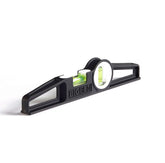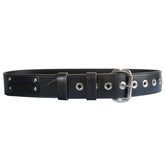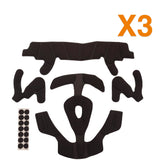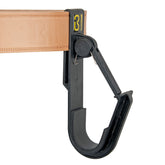The latest figures are in.
Tragically, within the scaffolding and construction sectors, there were 39 fatal injuries to workers and 4 to members of the public in 2020/21. This was a rise from the previous annual average of 36.
And you may’ve already guessed it. Falls from height was a major source of those fatalities, contributing to 50% overall. There were also 61,000 non-fatal injuries, 19% of which were attributed to falls from height[1].
These numbers are much lower than in decades previous, highlighting that the stringent health and safety protocols now in place have helped us cultivate an improved safety culture. But to push that trend down instead of up, we must keep banging the height safety drum. In this guide, we take a look at the ABCs of fall protection, and advise what fall protection equipment you need to stay safe when working at height
What is fall protection equipment?
If you’re working on a project that requires operations at height, fall protection equipment is a requirement to help you conduct your work with ease, while simultaneously preventing any serious injuries or fatalities.
Think safety harnesses, fall restraint lanyards, or work positioning belts. It’s this type of gear you and your team need to prevent a fall. But it’s important to use the correct equipment for your particular scenario.
An important first step before undertaking any work at height is therefore assessing the threats and risks. This will help you identify if the work at height is necessary and what dangers you might encounter, helping you procure and deploy fall protection equipment that will keep you safe. This review and assessment process must be undertaken by a competent and qualified person.
The ABCs of fall protection
Fall protection equipment consists of three different categories: fall restraint, fall arrest, and work positioning systems. Each of these categories follow the ABC’s of fall protection
- Anchorage – Anchorage is a security point of attachment (structure) for the fall arrest system to anchor to.
- Body support – A full body harness or work positioning belt provides a connection point on the worker for the fall arrest system.
- Connection method – Connectors, such as fall restraint or fall arrest lanyards, are used to connect the worker’s body support equipment to the anchorage system.
Fall Restraint Systems
As we’ve discussed in a previous blog, the safest form of protection is to first consider if it’s necessary to work at height in the first place. Your first port of call should be to carry out your work with two feet on the ground, if that is the safest option.
Once it has been deemed essential to conduct work at height, a fall restraint system should be used to prevent a fall from occurring. A fall restraint system is often utilised in facilities management and on rooftops to create a safe working environment. It essentially restricts the wearer from entering dangerous zones where a fall could happen.
A fall restraint system should include:
Anchorage - a suitable anchor point, tested to EN795 for Restraint or Fall Arrest.
Body support - a work positioning or restraint belt, or a full body harness.
Leach’s recommendation: BIGBEN® Deluxe Comfort Safety Harness

The BIGBEN Deluxe Comfort Safety Harness is a premium 2-point safety harness with elasticated leg straps and additional comfort pads on the shoulders and legs. It conforms to EN361, AS/NZS 1891.1&4, and has been independently tested and approved for wearers up to 160kg. It’s a popular harness amongst scaffolders and other professionals working at height
Connection method - a restraint lanyard or work positioning system.
Leach’s recommendation: BIGBEN® Webbing Restraint Lanyard with x1 Carabina and x1 Scaff Hook

The BIGBEN Webbing Fall Restraint Lanyard is the ideal connection point between the anchorage and body harness. It features a heavy-duty Scaff Hook for a safe and secure connection, and conforms for EN354:2010 & EN358:2001.
Fall Arrest Systems
A fall arrest system allows workers the freedom to move wherever they need to perform the job. Where this differs from a fall restraint solution is that it does allow a worker to reach a position where an accidental fall could occur.
If a fall does take place, a fall arrest system is there to ensure a worker is caught before falling. The required equipment must be chosen and located in a manner that limits the distance a worker can fall, therefore reducing the risk of serious injury.
A suitable fall arrest system should include:
Anchorage - a suitable anchor point, tested to EN795 for Fall Arrest.
Body support - a full body harness.
Leach’s recommendation: BIGBEN® Deluxe 2-Point HA Design Fall Arrest Harness

When working at height, you need a comfortable fall arrest harness you can count on. The BIGBEN Deluxe 2-Point HA Design Fall Arrest Harness delivers unparalleled comfort with special design leg straps. This is a premium safety harness that is BS EN 361 Certified.
Connection method - a fall arrest lanyard, energy absorbing lanyard or a self-retracting lifeline.
Leach’s recommendation: BIGBEN® Twin Elasticated Fall Arrest Lanyard with Wide Opening Alloy Scaffold Hook

The BIGBEN® Twin Elasticated Fall Arrest Lanyard comes with a unique compact wide opening alloy scaffold hook. It was designed to solve a common work ailment by delivering a more positive grip that keeps knuckles clear of the scaffold hook.
Work Positioning Systems
A work positioning system must keep a worker in place, while concurrently allowing the wearer to work hands-free. If the user is at an elevated height, a fall arrest system should be used in conjunction with the work positioning system to ensure that, if there is a user error or failure of the work positioning belt, a fall can still be prevented.
A suitable work positioning system should include:
Anchorage - a support structure such as a vertical rod.
Body support – work positioning belt with suitable attachment options.
Leach’s recommendation: BIGBEN® Work Positioning Belt

This Work Positioning Belt has been designed with safety in mind, featuring two connection points – one on each side of the waist. It’s available in size M-XL (85cm – 120cm waist).
Connection method - a positioning lanyard.
Leach’s recommendation: BIGBEN® Braided Rope Restraint Lanyard

The BIGBEN® Braided Rope Restraint Lanyard helps prevent the wearer from entering areas of risk. It’s available in 1m and 1.3m lengths, and conforms to EN354:2010 and EN358:2001.
Don’t be a Statistic – Protect Your Team with Fall Protection Equipment from Leach’s
We all know that working at height presents many dangers. We must understand what those dangers are in order to effectively mitigate against them.
Businesses that excel at implementing stringent safety measures, and who choose the most appropriate fall protection equipment, will be successful in reducing the risk of injuries to workers. Explore Leach’s range of height safety equipment now, or contact our sales team on 01432 346890 for further guidance.
[1]https://www.hse.gov.uk/statistics/industry/construction.pdf


















